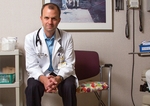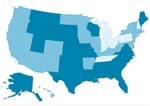Profession
The politics of progress: How to continue stem cell research despite limitations
■ Work on embryonic stem cells proceeds as states and universities find ways to work around federal restrictions on access and funding.
By Andis Robeznieks — Posted Aug. 9, 2004
- WITH THIS STORY:
- » How 78 became 19
- » Stem cell time line
- » Embryonic stem cell stats
- » External links
- » Related content
University of Minnesota officials knew they would make some people angry when they decided to forgo federal funding and conduct research on human embryonic stem cells that are not on the National Institute of Health's approved stem cell registry
They made the decision last December but waited until the Minnesota Legislature ended its session in mid-June before embarking on a $50 million fund-raising campaign, because they could not gauge the impact the anger would have on their efforts.
"There was ... activity at the legislative level to promote stem cell research in the state and, in essence, to also defund the entire university if it did any human embryonic stem cell research," said University of Minnesota Stem Cell Institute spokeswoman Sarah Youngerman.
The controversy surrounding embryonic stem cell research has abated little since President Bush announced Aug. 9, 2001, that the federal government would fund research on only the 78 stem cell lines in existence on that date. His administration has held firm to that policy, even though it has since become clear that only about one-third of the promised stem cell lines would be useable or available to researchers and even though some experts believe that stem cells created since Aug. 9, 2001, are of a higher quality than existing ones because they were not cultured with animal cells.
AMA policy approves of embryonic stem cell research but says physicians should be free to decide whether they want to participate in the research or use the products it could produce.
While some applaud the president's resolve to stand by his original decision, others, such as the University of Minnesota, are looking beyond federal funding. Several states, universities and private institutions are going around the Bush policy rather than trying to work within its constraints.
The roster includes New Jersey, which has allocated $6.5 million to help launch a state stem cell research institute, and California, where voters will decide this November whether to fund a $3 billion plan to provide 10 years' worth of state-supported stem cell research.
The University of California, San Francisco, and Harvard University also are going ahead with plans to privately fund research centers.
At Harvard, Professor Douglas Melton, PhD, has developed 17 new stem cell lines, which he is offering to qualified researchers for free. Lines on the NIH-approved stem cell registry cost $5,000 to obtain.
Accurate figures on the number of stem cell lines developed since August 2001 are difficult to obtain, but estimates range from 70 to 176, and it's generally believed that the number will continue to grow and the quality and diversity of the new stem cells will improve.
"This is what we said would happen," Youngerman said. "Regardless of the federal government's position, this research will go forward."
James F. Battey Jr, MD, PhD, who chairs the NIH Stem Cell Task Force, said he doesn't oppose the efforts to advance stem cell research beyond the reach of the NIH. "I think anything that will accelerate the pace of discovery should be welcomed," he said. "We welcome all responsible partners."
Patients are the motivation
Indeed, seeing and treating patients who could benefit from the breakthrough treatments stem cell research could discover helps keep most researchers out of the accompanying political maelstrom.
"We get letters from desperate family members asking 'Is there anything we can do?' " Dr. Battey said. "When you read those letters, you're motivated to do everything you can."
Agreeing is University of California, San Diego Professor of Cellular and Molecular Medicine Larry Goldstein, PhD, a scientific adviser for Californians for Stem Cell Research and Cures, the organization that led the effort to get the stem cell referendum on the November ballot. He said his work with patients with amyotrophic lateral sclerosis keeps him motivated.
"You can't meet these people and not be moved to work as rapidly as you can," he said.
Youngerman said she gets 15 calls a week from desperate patients who are hoping that the university's research can help them. She said many offer to be "human guinea pigs" for stem cell experiments, and she wonders what it's like for physicians.
"I think it's a tough spot for physicians to be in," she said. "They have patients coming in and saying, 'Can't you fix this?' but we're still five to six years away from human trials."
For these patients, Bob Goldstein, MD, PhD, chief scientific officer for the Juvenile Diabetes Research Foundation, said politics is not an issue. "I'll bet most of their patients are saying, 'If there's something out there that can help me, why not do it?' " he said.
Although more and more institutions are working around the federal policy, Dr. Bob Goldstein said its impact is still significant.
"This is not a speed bump. We have an entire area of biomedical research that the NIH frowns upon," he said. "The net effect is that the research will go forward, but it's a trickle compared to what [it] could be."
Dr. Battey disagreed. He said it is a lack of stem cell researchers and not funding that has slowed progress.
Noting that NIH funding for human embryonic stem cell research more than doubled from $10.6 million in fiscal year 2002 to $24.7 million in fiscal year 2003 (compared with $170 million and $190 million for adult stem cell research), Dr. Battey said NIH programs are growing, and he's hoping they will continue to do so.
"We don't have a set amount of dollars for either [adult or embryonic stem cell research]," Dr Battey said. "The amount we spend is driven by the grant applications we receive that do well in our peer-review process. There is no cap on the amount that NIH is willing to spend."
Dr. Battey recognizes the limitations of the 19 available stem cell lines, but he said they are suitable for the basic research being conducted.
He maintains that a shortage of scientists is what's holding up the research. NIH has sponsored five stem cell training courses lasting from one to three weeks that included 15 to 25 scientists each. He said that twice as many people applied as there were spaces to accommodate them.
Youngerman confirmed that there could be a scientist shortage, at least as far as the University of Minnesota is concerned. "I know it's been tough for us to recruit, because the pool of talent is not as large as in other areas of research," she said. "There are key positions we're still looking to fill."
Drs. Bob and Larry Goldstein both said uncertainty surrounding the politics of stem cell research is making young scientists wary about entering the field.
"It shouldn't be a surprise that there are so few applications, because people are nervous about pursuing this," said Dr. Bob Goldstein. "What if they make this illegal next year?"
Dr. Larry Goldstein said the feared "brain drain" of established scientists going to other countries might not have materialized, but the bigger danger is that there won't be younger researchers to replace the older ones. "The erosion will be slow and, by the time you can prove it happened, it will be too late," he said.
Other experts worry that the United States will be left behind in this area of research as a result of the Bush policy.
"The number of post-Bush stem cell lines developed outside the United States is probably significant, because the research is progressing without us," said Kevin Wilson, director of public policy for The American Society for Cell Biology, based in Bethesda, Md.
"There's no elasticity in the Bush policy and, because the policy is stuck in 2001, federally funded science won't be able to move forward as science develops."
Significant developments in other countries include the launching of a $287 million stem cell research center in Singapore and a $30 million center at London's University of Cambridge.
These centers have gotten the interest of the U.S. Senate. Sen. Orrin Hatch (R, Utah), who co-wrote a letter to the president asking him to reconsider his stem cell research funding policies that was signed by 57 other senators.
"This research is going to go forward, regardless, and it would be in our best interests to have it happen here in the United States under strict ethical guidelines established by our NIH," said Adam Elggren, communications director for Hatch. "People see the value in that position."












